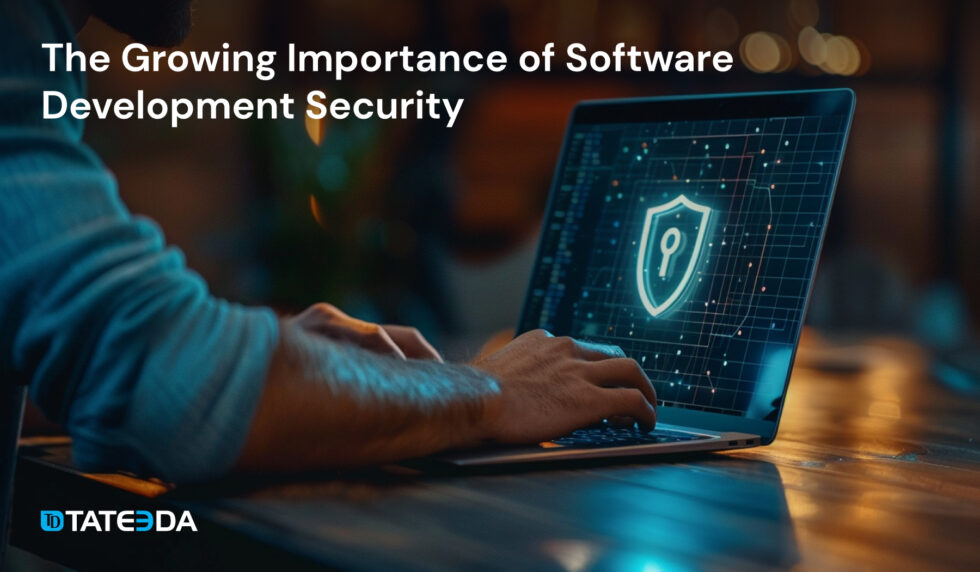The Growing Importance of Software Development Security

In this article, you will learn about the importance of software development security via expert advice from TATEEDA GLOBAL. This article also covers multiple aspects related to establishing a secure software development lifecycle in project teams, including IT security and privacy measures for software systems in various industries and organizations.
As digital data transfer becomes increasingly common for businesses of all sizes and genres, security has moved to the forefront as an important and integral element of the software development lifecycle (SDLC). Data breaches pose enormous threats to the privacy of individuals and the integrity of companies whose responsibility it is to safeguard sensitive information. As a business owner, you cannot afford to overlook security when adopting customized software to your business processes.
| ? If you have a cyber security project and/or are seeking technical consulting or outsourced IT services that incorporate the best secure development practices in web, mobile, or desktop domains, please book a free chat with our secure software engineering expert. |
What is software development security?
According to modern IT conceptions, software development and security processes go hand in hand—each aspect of the Software Development Life Cycle (SDLC) must be architected to incorporate security-oriented components. These efforts lead to establishing a coordinated network of data security precautions that safeguard all the information used throughout the project flow and predefine high-quality IT products purged of data-threatening bugs, code loopholes, and software design blunders.
Why is software security important? Before we learn more about secure SDLC and the importance of security in software development, please consider our deep expertise and services in these fields. TATEEDA GLOBAL completely embraces the importance of software security and meticulously works to implement the best practices in every project we undertake.
Ready to Develop a Secure Application?
Benefit from our decade of expertise in crafting safeguarded applications for the medical and fintech industries.
Table of Contents
Creating a Secure SDLC
In the past, security was somewhat of an afterthought in software development, taken into consideration during the testing phase. But new methodologies like Agile build ongoing testing into every phase of the SDLC, and that includes testing for secure software development.
Hackers and cybercriminals are constantly seeking new ways to exploit the vulnerabilities of software systems. By making security a priority throughout the SDLC, developers, and stakeholders have more opportunities to troubleshoot potential security risks, and fix them early on as an integral part of the software development process.
Integration of software development security principles and continuous testing efforts across the SDLC appear to be much cheaper and more beneficial than testing and patching up security gaps overnight before release.
Security testing should be a continuous area of attention, not a one-time reactionary effort. If you want to avoid bumping into costly vulnerabilities in software use (nobody wants this!), don’t overlook crucial foundation-building during the design and development phase.
Application development security is called security assurance (similar to quality assurance), and it all spins around the following factors:
- Continuous software architecture analysis throughout the design phase
- Continuous code reviews throughout the development phase
- Profound penetration testing (simulated hacking attempts) before product release.

Why is security important in software development?
A secure SDLC will consistently generate the following benefits for your company:
- Removal of design blunders before they are embodied in code
- Lower costs, thanks to early detection and elimination of security flaws
- Stakeholders will embrace the importance of investment in secure methodologies, and will not push nearshore software developers to release software more quickly at the cost of security.
What is an SDLC workflow, step by step?
- Software Concept + Planning
- Software Architecture + Design
- Software Implementation (development)
- Software Testing + Bug-fixing
- Software Release + Maintenance
- End-of-life Phase
Let’s check out the best security practices and most favorable activities that should be incorporated at every step of your SDLC…
Step #1. Concept and Planning
This step includes…
- Defining security requirements and success/compliance goals for the project
- Selecting a secure SDL methodology
- Security awareness training for team members
- Allocating human resources with expert knowledge/skills in application security.
Step #2. Architecture and Design
This step includes…
- Secure software engineering supported by multiple design reviews to make sure no security defects are left deep in the design
- Cyber-threat modeling: defining probable attack scenarios and implementing counter-measures within software architecture
- Checking any involved third-party software for vulnerabilities.
Begin Developing Secure Software Now!
Since 2013, a secure development process has been organically integrated into our workflows. Let’s discuss your custom software development to ensure sensitive data is protected.
Step #3. Implementation
This step includes…
- Applying and improving security principles in coding routines
- Static code scanning and manual/automated code reviews
- Practicing individual security habits and basic data-protection measures at the level of each individual team member.
Step #4. Testing and Bug-fixing
This step includes…
- Discovering and fixing application errors
- Keeping consistent QA documentation
- Using multiple methods to ensure the highest code quality
Step #5. Release and Maintenance
This step includes…
- Constantly improving software security features
- Logging and incident-spotting/response
- IT environment management and improvement of user culture
- Security checks and diagnostics
Step #6. End of life
Since the software is no longer supported at this stage by its creators, every piece of important or sensitive data it may contain should be carefully protected and retained, or terminated altogether.
Let’s learn more about the importance of these steps and the main causes of security violations and data breaches…

Read also: Top 7 Nearshore Software Development Companies
Common Causes of Data Breaches
Before we address the usual reasons for security failures that lead to disastrous data leaks, let’s briefly look at what data breach means.
A data breach is an incident during which any type of protected information…
- Is stolen by hackers
- Is accidentally exposed to the public (even if nobody takes advantage of it)
- Is unintentionally shared with anyone who is not authorized to view it.
Unfortunately, even technological giants can fall victim to negligence in software security, which often leads to large and painful data breaches.
It’s important to note that data breaches do not always happen as the result of hacking or inadequate software architecture.
Instead, data leaks can stem from a wide spectrum of technological mismanagement and human error. It’s a curious fact that in many cases, there were NO intentionally malicious efforts applied.
Even with no cybercriminals or malware behind the incidents, the involved companies and their clients suffered costly data breaches.
Let’s learn exactly how this happened to several famous organizations…
Software Misconfiguration
In January 2020, Microsoft admitted that they leaked a corporate database containing more than 250 million anonymized customer records over a period of 14 years. The database contained email addresses, IP addresses, and other client details collected in the context of Microsoft’s internal customer support services.
The database was accidentally discovered by a third-party security investigator. It was readily accessible, without any real password protection or authorization.
Microsoft reported that the reason for the incident was that certain misconfigurations in their database’s network security group had failed to comply with security rules.
What lesson does this teach us? The practice of maintaining a secure SDLC includes rigorous configuration of server settings and other tech details so that no software test facilities, virtual machines, server folders, files, databases, or other confidential software objects are freely accessible from the outside or protected only by weak passwords.
Middleware Security Failures
In 2020, Estée Lauder, a giant manufacturer of skincare and makeup products, left their customer base with more than 440 million records accessible to anyone.
It included a lot of technical information that could have provided hackers with a base for further sophisticated network attacks: email addresses, IP addresses, ports, pathways, and storage information. Everything was exposed and easily found by a security researcher (white-hat hacker) through cracks in middleware that could otherwise have been used by hackers or malware.
What lesson does this teach us? Most likely your dedicated software development team (and the final product, too) rely on third-party software or platforms for a variety of functions. It’s necessary for your secure SDLC approach to take into account the whole chain of middleware systems involved in the development and production cycle, so no data breaches can happen in the process of data interchange.
Human Error
Many studies suggest that more than 90% of data breaches are caused by human error of different types, from weak passwords to unsafe personal communications.
A classic example of this type of human-induced data breach also happened to…the military.
It’s hard to believe, but U.S. Marine Corps Forces Reserve employees once erroneously e-mailed an unprotected database containing personal info and bank account details belonging to thousands of Marines, sailors, and civilian workers to multiple recipients, some of whom were not authorized to view the data.
What lesson does this teach us? A security-focused culture must be fostered across all team members so no silly mistakes can be made.

Software that Demands Secure Development
While it is important to factor security into any type of software development, there are certain industries and organizations that have exceptional security SDLC requirements.
- Banks and financial institutions
- All types of healthcare systems
- Payment management systems
- Government agency databases
- Large retailers that store customer data
- Online stores and marketplaces
- Businesses in fiercely competitive markets or industries
- Social networks and dating applications
Even if your business is a startup that does not currently store secure data, if you plan to scale in the near future, it is best to incorporate advanced security features into your website, applications, and other software programs from the very beginning.
| Cause of Data Breach | Notable Incidents | Lessons Learned | High-Risk Sectors |
|---|---|---|---|
| Software Misconfiguration | Microsoft’s 250 million customer records leak (2020) | Emphasize secure configurations in the SDLC to protect against unauthorized access. | All sectors, notably technology companies and online services. |
| Middleware Security Failures | Estée Lauder’s 440 million records exposure (2020) | Ensure thorough security reviews of third-party middleware to prevent data leaks. | E-commerce, healthcare, financial services, and any sector relying heavily on third-party integrations. |
| Human Error | U.S. Marine Corps Forces Reserve’s unprotected database email incident | Foster a security-focused culture across all team members to minimize human errors. | Military, healthcare, financial institutions, and any sector handling sensitive personal data. |
| Demand for Secure Development | Banks, healthcare systems, payment systems, government agencies, large retailers, online stores, social networks | Certain industries require exceptional security measures in their SDLC due to the sensitivity and volume of data they handle. | Banks, healthcare, government, retail, e-commerce, competitive industries, social networks. |
Are You Developing Secure Software for Your Business?
If you need help with secure enterprise software development, our experts in .NET and SQL database technologies are ready to reinforce your current team.
If you’d like to delve into details of our secure medical solution development practice, click on the links below:
- Medical staff scheduling solutions
- Web/mobile patient portals
- Patient electronic data capture solutions
- Remote health monitoring apps
- Automated laboratory testing systems
- Pharmaceutical business automation solutions
- Pharmacy claims-processing and medication fulfillment
- And much more….
Read also: How to Develop a Secure Hospital Management Software System
Why Do Developers Skip Security Preparations?
Simply put, there are three options, but you can only choose TWO of them:
- Launch your product to the market fast
- Deliver all your killer features with the first release
- Adhere to the best practice of secure software development and quality
We have all been there…
Unfortunately, many project managers and company executives opt for sacrificing software development security to other things considered more important to their short-term business objectives.
When people choose between getting to market quickly (this is usually demanded by business owners), building more competitive features, or investing more time/effort into the quality/security assurance of their products…security in software development is often neglected.
And that’s a big mistake…
With modern, agile software development techniques, it’s imperative not to neglect software security.
Instead, best practices in agile development allow you to organically include security-focused QA procedures at every step.
At TATEEDA GLOBAL, we are masters of agile methodology, and we know a thing or two about a secure development lifecycle.
If you’re interested in building HIPAA-compliant healthcare software, be sure to contact us.
Benefits of Secure Software Development
Custom software that incorporates security measures through the development process ensures that your software satisfies the unique requirements of your organization for flawless performance with minimal security risks. The generic nature of off-the-shelf software solutions makes them inherently less secure, and less likely to satisfy your specific needs over the long run.
There are numerous advantages to optimizing software security throughout the SDLC:
- Improved software performance
- Reduced business risks
- Reduced costs for software flaw detection and fixes
- Ongoing compliance with laws and regulations governing security, saving money on fines and penalties
- Increased customer trust and loyalty
- Better internal organizational security
If you want your systems to perform for years without failures or security breaches, it is important to work with a professional software development agency that can design, develop and maintain your software with the latest innovations in security.
Read more: How to Maintain and Support Healthcare Software

Risk Factors in Secure Software Development
Here is a list of factors that can endanger your secure software design:
- Too many “moving parts” in the system. Complex software interdependencies can be ripe for weak links and unsafe data communications or incidents, especially when these issues are known but not properly addressed.
- Large multi-level software solutions require lengthy, complex quality assurance procedures. These are often skipped by project developers in favor of a faster to-the-market product launch.
- Outsourced third-party software components and integrations create a high-risk zone, as they can contribute their own vulnerabilities to the final product.
- Sophisticated hacking, phishing, and ransomware attacks. Sometimes, attackers identify specific flaws in your security barriers and exploit them to interfere with your software system.
- Legacy software that was not properly upgraded is then reused without covering security gaps.
- The human factor, user-generated errors, and psychological vulnerabilities. Negligence in security matters, weak passwords, poor security culture/tech skills, and other “deadly sins” against cybersecurity are all found in the field of software development.
At TATEEDA GLOBAL, we always work to control a multitude of risk factors to make sure we produce only highly secure and well-tested software solutions. Our software specialists and project managers are experts in software engineering security, so they know how to avoid and eliminate all potential software design flaws as early as possible.
Thanks to our resources, we are capable of delivering HIPAA-compliant medical software solutions within tight deadlines.
Contact us to discuss your next project or learn more about our services: ?
Custom Healthcare Solutions
See how we can engineer healthcare software, validate your ideas, and manage project costs for you.
Secure Development Requires Secure Coding
How developers write code, and the ways it is monitored and updated, can have a profound effect on organizational security. The gold standard for secure coding is provided by the Open Web Application Security Project (OWASP), who published a list of secure SCLC techniques entitled “Top 10 Proactive Controls.”
OSWASPs top 10 proactive security controls for coding include:
#1. Defining your project’s security requirements
Security requirements and criteria should be incorporated into every stage of the software development process, including software architecture and product usability concepts.
All weaknesses and potential security gaps should be identified as early as possible and properly handled. These measures should include, where possible:
- Setting reasonable constraints on how certain processes behave and operate (so if hackers try to take control, they won’t be able to interfere with the whole system in a serious manner)
- Improving the system’s ability to resist unintentional and/or intentional failures (for example, many hacker attacks are based on flooding and overloading systems with fake queries until they lose manageability.)
- Implement secure multi-core software design to avoid unforeseen interactions between threads and processes.
- Make sure to plan a definite hierarchy of project roles, and manage their access rights in accordance with their responsibilities.
#2. Using up-to-date, secure libraries and frameworks
It’s essential to avoid middleware issues, vulnerabilities, and data leaks. This can be achieved in a number of ways, including:
- Use only the latest, safest versions of software development tools and components.
- Use software libraries and components that come from trusted vendors, are actively supported, and have a sufficient amount of positive feedback.
- Maintain a software component registry to control all the third-party components involved in the development process.
#3. Securing access to databases
Databases are among your most valuable assets. They should be properly configured and protected, so no unauthorized access or data leaks are possible via overlooked cracks in the local network firewall or any other form of tech mismanagement.
#4. Using encoding and escaping techniques
Encoding and escaping are defensive methods used to prevent injection attacks. They refer to certain code modification techniques required to prevent malicious code or any changes to the course of program execution.
#5. Validating inputs syntactically and semantically
Adherence to the highest coding standards helps developers nip many bugs and code issues in the bud. There are a variety of different ways to ensure that code is sustainable, consistent, readable, efficient, and safe, and that no incorrect inputs are accepted by software modules (including whitelisting and blacklisting techniques.)
Make sure you have a properly calibrated input validation strategy in place.
#6. Implementing digital user identity
It’s necessary to have all of these things in place…
- Strong password requirements
- Password recovery procedures
- Multi-factor authentication
- Cryptography requirements
- Session management
- Web browser cookie management
- Security token generation
- And more…
#7. Authorizing user requests
Access control and authorization is the process of granting/denying requests from a variety of actors: users, applications, or processes. There exist several types of access-control models to be considered and adopted:
- Discretionary Access Control (DAC)
- Mandatory Access Control (MAC)
- Role-Based Access Control (RBAC)
- Attribute-Based Access Control (ABAC)
#8. Adding extra protection for sensitive data
Sensitive data (passwords, credit card details, medical records, personal data, financial and business records, etc.) requires the best levels of protection. That includes encrypted data transmission, secure data storage, and other protection-focused data management practices.
#9. Logging and monitoring security information
Logging is necessary to keep track of any unusual software behaviors. A properly configured logging process helps to catch security incidents early so you can identify, investigate, and handle all sorts of suspicious behaviors within the system before they evolve into a real data breach.
#10. Handling exceptions and errors in all areas
Exception handling is very important for system sustainability, as it determines how your application will react to a number of errors or unpredictable states. If your software system can rely on a set of efficient emergency scenarios, it won’t crash or succumb to any other unfavorable scenarios.
Since coding provides the foundation for any type of software or application, it makes sense to prioritize security during every phase of the coding process.
Updating Software Security
Even if security was prioritized during the development of your organization’s software, periodic updates are necessary to outpace cybercriminals and hackers. Having your software systems tested for bugs, flaws, and vulnerabilities on a regular basis can save you money in the long run and protect you from data breaches that undermine your brand’s integrity and harm your reputation.
There are several reasons to update your software security on a regular basis:
- Replace outdated or obsolete security features with the latest upgrades
- Uncover flaws and vulnerabilities and repair them before hackers can detect them
- Detect malware or viruses that have infiltrated your systems, putting you at risk for data theft and system corruption
- Protect your clients and associates from viruses and malware being passed on without your knowledge
Establish a regular, intensive testing process
It’s necessary to quality-approve every line of code as soon as it’s written, so no under-tested code fragments are included in the final release and become potential gateways for data leaks and cyber intruders.
Employ the following QA practices on regular basis:
- Test code inherited or borrowed from previous or legacy projects.
- Test often and regularly throughout your SDLC. Never compromise.
- Execute static code analysis. This helps you spot memory leaks, access violations, mathematical errors, array/string overruns, and more.
- Execute both manual and automated code reviews.
- Perform requirements-based testing.
Read more: Guide about medical device software testing.
A professional software development agency can provide ongoing security maintenance and upgrades to your systems and applications, so you never have to worry about security breaches or system failures. If you wait until something fails before you fix it, you risk losing important data, exposing sensitive information, and disrupting your business operations.
| TATEEDA GLOBAL employs secure software development best practices and is ready to share our experience with you. We have developers skilled in the following areas: ✔️ EHR & EMR software development ✔️ DevOps business services ✔️ Custom IoT solution development ✔️ Telemedicine application development ✔️ Biotechnology lab system development View our successful projects in the portfolio: ? |
Delivered Healthcare Software Portfolio
The leading American healthcare companies benefit from working with us.
Secure Software Development at Tateeda
Today’s sophisticated technology requires advanced security to protect it from software breaches that cause malfunctions and failures. Digitization of sensitive data makes it vulnerable to cybercriminals who want to exploit it for financial gain.
At TATEEDA GLOBAL, with a native R&D office based in Ukraine, we design custom software solutions with security built-in at every stage. We work with our clients to ensure your unique needs for performance and security are met throughout the SDLC. Contact Tateeda today, and let us custom-design software solutions that meet your needs for the 2020s and beyond.
Learn more about the medical software we produce:
- Patient Electronic Data Capture Solution Development
- E-Prescription Software Development
- Custom EHR/EMR Software Development
- Patient Portal Development Guide
- Medical HR Software Development
- Pharmacy Management Software Development
- Medical Staff Management and Scheduling Software Development
- mHealth App Development: The Ultimate Guide
- Remote Patient-monitoring Software Development
- Remote ECG-monitoring Software Development
- Cardiology EHR/EMR Software Development: Benefits and Features
- The Benefits of Healthcare IT Outsourcing for Your Medical Facility








